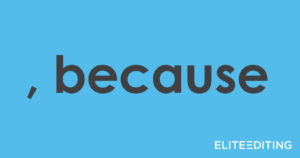 Perhaps because it is one of the most common punctuation marks, the comma is also one of the most commonly misused. Unnecessary commas abound, but this guide will help you steer clear of most common comma mistakes.
Perhaps because it is one of the most common punctuation marks, the comma is also one of the most commonly misused. Unnecessary commas abound, but this guide will help you steer clear of most common comma mistakes.
Avoiding Unnecessary Commas
Knowing when to use commas includes knowing when not to use them. Unnecessary commas are a common grammatical error and occur in a variety of sentence constructions. For instance, a comma should never separate a subject from its verb. Unnecessary commas do this all the time:
- Incorrect: The last doughnut, is Jim’s.
- Correct: The last doughnut is Jim’s.
By the same token, a comma should not separate a verb from its direct object:
- Incorrect: I knew immediately, what the alarm meant.
- Correct: I knew immediately what the alarm meant.
In this case, “what the alarm meant” is the direct object of the verb “knew,” so it should not be separated from its verb by a comma.

Common Comma Mistakes
With these quick and easy tips, you’ll be a pro at sidestepping common comma mistakes, from avoiding comma splices to connecting independent clauses to communicating your meaning clearly.
What Are Comma Splices?
A comma splice is a type of run-on sentence. A run-on occurs when two clauses that can stand alone as sentences are presented as a single sentence. A comma splice is a run-on that occurs when two independent clauses are connected by a comma without an appropriate conjunction. “The man ate the pie, he didn’t pay the bill” is a comma splice. “The man ate the pie” and “He didn’t pay the bill” are independent clauses. The sentence can be fixed in three different ways.
You can separate the two clauses into independent sentences:
- The man ate the pie. He didn’t pay the bill.
You can use a semicolon to properly connect the two clauses:
- The man ate the pie; he didn’t pay the bill.
Or you can add a conjunction:
- The man ate the pie, but he didn’t pay the bill.
Is There Always a Comma before “But”?
“Is there always a comma before ‘but’?” is a common comma question, and a good understanding of coordinating conjunctions will provide the answer. In one of the examples above, “but” was used as a conjunction to correct a comma splice. One of the most common comma mistakes is not using a comma before a coordinating conjunction (such as “but”) when the conjunction connects two independent clauses:
- Incorrect: The man ate the pie but he didn’t pay the bill.
- Correct: The man ate the pie, but he didn’t pay the bill.
If you’re wondering whether there is always a comma before “but,” remember that the comma is only correct if the two clauses are both capable of standing alone as independent sentences. If the sentence has only one subject but has two verbs or objects, you shouldn’t use a comma:
- Incorrect: The pie is tasty, but too sweet.
- Correct: The pie is tasty but too sweet.
The phrase “too sweet” is not a complete sentence, so you don’t use a comma before “but.”
Do You Use a Comma before “Because”?
“Because” is a conjunction that connects a dependent clause to its main clause. You do use a comma before “because” if the dependent clause that comes after it is merely supplementary—or parenthetical—information. Usually, you don’t need the comma at all:
- I like eating pie because it is tasty.

In this example, a comma is not needed because the meaning of the sentence is clear. But sometimes, meaning can depend entirely on the presence or absence of a comma. In this example, the clause following “because” could give the sentence two meanings:
- He didn’t ask the woman out because she was pretty.
Did he not ask her out due to her pretty appearance, or did he actually ask her out for a different reason? The sentence is unclear. If you do use the comma before “because,” the second part of the sentence becomes an extra bit of explanation of the man’s actions:
- He didn’t ask the woman out, because she was pretty.
Here, the sentence implies that perhaps this man is intimidated by attractive women, so he doesn’t like to ask them out.
In the example above, If you don’t use a comma before “because,” your sentence could mean the man asked the woman out for reasons other than her prettiness. You may need to add more information to make the situation clear:
He didn’t ask her out because she was pretty; he was attracted to her quick wit.
Using a Comma before “Please” or a Comma after “Please”
Whether you put a comma before “please” or a comma after “please” depends on the tone you want to strike and on the position of the word “please” in the sentence.
When Do I Use a Comma after “Please”?
Let’s talk about tone first. For example, you could say this:
- Please take out the trash.
That’s perfectly acceptable. But you could also use a comma after “please”:
- Please, take out the trash.
By adding the comma after “please,” the sentence changes tone, and the “please” sounds more irritated and exasperated. Both sentences are correct, but their tones are very different.
When Do I Use a Comma before “Please?
It’s generally fine to use a comma before “please” when it comes at the end of a sentence. But watch out! If you see a comma before “please” in the middle of a sentence, you may have run into one of those dreaded comma splices:
- Incorrect: I would like some pie, please bring me the dessert menu.
In this case, you must remove the comma before “please” and fix the comma splice:
- I would like some pie. Please bring me the dessert menu.
- I would like some pie; please bring me the dessert menu.
- I would like some pie, so please bring me the dessert menu.
Not Only / But Also Comma Usage
“Not only” and “but also” are what are known as correlative conjunctions (much like “either/or” and “neither/nor”). Correlative conjunctions connect two parallel clauses or words. The “not only but also comma” issue is one that comes up a lot, but the quick and dirty rule to remember is that parallel verb or noun elements do not require commas:
- Incorrect: He was not only a good friend, but also a great brother.
- Correct: He was not only a good friend but also a great brother.
- Incorrect: The stolen vehicle was not only moving rapidly, but also veering wildly.
- Correct: The stolen vehicle was not only moving rapidly but also veering wildly.
When faced with the “not only but also comma” issue, remember that in most cases, you won’t need that unnecessary comma!
With these common comma mistakes out of the way, your writing will be better than ever. Join us for future articles on grammatical issues, or check out our list of 10 common writing errors and how to correct them. Or check out our description of different editing styles to gain insight into how your editors think.








